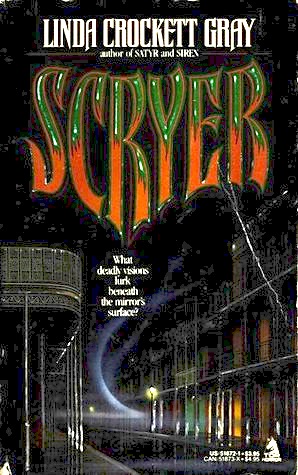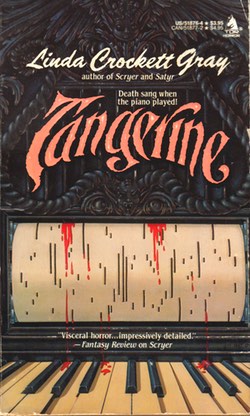In this series, Grady Hendrix, author of Horrorstör, and Will Errickson of Too Much Horror Fiction are back to uncover the best (and worst) horror paperbacks from the 1980s.
In Tangerine by Linda Crockett Gray, you haven’t reached page 34 before you reach this passage about a ring of porn kings who shoot specialty videotapes. Their latest commission is pricey because the fantasy they’re realizing involves a woman suffocating an 11-year-old boy to death with her breasts. Then she covers the boy in flowers and eats them off his dead body. The customer? A podiatrist in Utah who paid $2,000 for this masterpiece of cinema.
With sleaze this deep so early in a book, you kind of feel like you’ve won the lottery. Then you read the rest of this 344 page novel and you realize: no. Reading Linda Crockett Gray is like the lottery, only it’s the real one, where you always lose.
I don’t have anything against Linda Crockett Gray and I say that up front because it’s going to sound like I do, but it’s really not her fault. When you read a bunch of old horror paperbacks from the 80s you’re bound to get some clunkers, it’s just the luck of the draw. Outside a small percentage of received classics, books from this era and genre don’t have online reviews of more than a sentence or two, and confronted with a wall of unfamiliar garish, stepback, foil-encrusted covers in used bookstores by authors you’ve never heard of, sometimes you just have to say a prayer and start grabbing and gorging.
That’s how I picked up Linda Crockett Gray’s books for a buck each based on nothing more than what I’d heard about her first novel, Satyr (1981), famously published by Playboy Press. By all accounts, it’s a wild ride about a woman on the trail of a serial rapist whose victims inevitably wind up drowning themselves because it turns out that the perpetrator is a satyr with psychic powers. This kind of thing happened a lot in the 80s—people writing books that would not pass an editor’s muster in 2015, not psychic serial rapist satyrs terrorizing women—so I was excited to find copies of her two books published by Tor, Scryer (1987) and Tangerine (1988).
The loglines are promising enough. Scryer is about an ex-cop-turned-celebrity-cookbook-author tracking down a cult of kill crazy sex magicians with the help of a waitress who can spy on people in the bathroom through her psychic link with their mirrors. Tangerine is about a computer hacker who buys a player piano possessed by the spirit of a “beautiful young mulatto” pianist/prostitute murdered in the 1940’s who is seeking revenge against the men who killed her who are now involved in a snuff-porn ring in modern day Baltimore. It hurts me to write this but: both books are coma-inducing.
 Scryer is the slightly more interesting of the pair as its literary model is early 90s made-for-cable late night erotic thrillers. Everything is tacky and obvious, but that doesn’t mean it’s bad. There are a series of occult sex murders that are disreputably enjoyable, and a kooky cult of rich people who invent new drugs, walk around the bad part of town in floor-length fur coats, and lure their victims into Rolls Royces before injecting them with hypodermics, and that’s always fun. But then the descriptions start.
Scryer is the slightly more interesting of the pair as its literary model is early 90s made-for-cable late night erotic thrillers. Everything is tacky and obvious, but that doesn’t mean it’s bad. There are a series of occult sex murders that are disreputably enjoyable, and a kooky cult of rich people who invent new drugs, walk around the bad part of town in floor-length fur coats, and lure their victims into Rolls Royces before injecting them with hypodermics, and that’s always fun. But then the descriptions start.
For some reason, Linda Crockett Gray has decided that what readers really want are untenably long, unbearably detailed descriptions of made-up psychic abilities. Psychic warfare is a plot point, so okay, but come on:
“Staring into Lennie’s eyes, she could see the air surrounding his body turning hazy, shimmering slightly with the colors of his hair and skin. But then the colors became more lovely—pale rose, delicate yellow, warm orange—as if his body were lifting into the air and melting into space. His eyes stayed locked onto hers though they seemed more luminous and far larger than before. His face became so vast it filled her line of vision as it expanded in a cloud of color that seemed to welcome her.”
That’s from an 11 page (!) sequence of two people sitting, staring into each other’s eyes. Exhaustive, near-compulsive descriptions of irrelevant minutiae from menu items, to exhaustive backstories of every single character, to people writing in their journals for entire chapters quickly overwhelm the book until even a climax where the lead characters use the powers of their psychic sex to explode a giant mirror and kill all the bad guys is about as exciting and pulse-pounding as listening to your Aunt Emma recite the 42-step recipe for her Mudslide Pie.
Tangerine is even more obsessed with finicky details because its plot revolves around a bunch of bad guys who are engaged in an elaborate money laundering scheme using the databanks of a health care provider…and the lone female systems administrator who stands against them. That yields juicy passages like:
“It was her systems design. She would have to change both the passwords and the entry procedure while Dink used the BSS system to intercept and monitor any transactions until the new method was operative. All authorized Unico users would have to be updated on the revised procedure, preferably before regular business hours resumed Monday morning.”
Most people read memos like this as part of their jobs. On the other hand, if anyone has an interest in late 80s computing, I highly recommend Tangerine because there are long passages on programming, database architecture, and file retrieval that seem well-researched. They just aren’t very interesting.
I’m not writing this review to trash Linda Crockett Gray, but there aren’t many reviews of her books online, and just as people should be pointing out the treasures and the trash for fellow paperback spelunkers, there need to be warning signs, too. So I’m the guy standing by the side of the road, waving a lantern in the rain, warning those kids before it’s too late, “Turn back. Turn back! There’s nothing for you at the old Crockett Gray place…except death.”
Grady Hendrix has written for publications ranging from Playboy to World Literature Today and his latest novel is Horrorstör, about a haunted Ikea.










